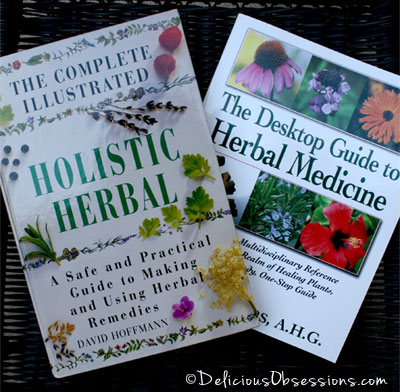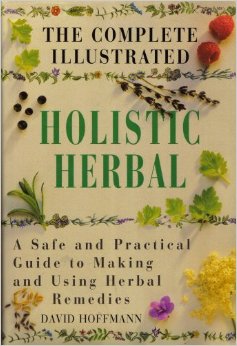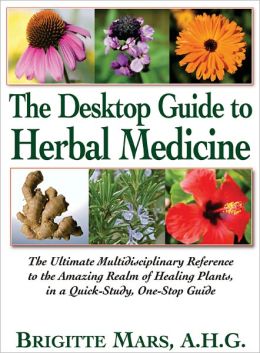FTC Disclosure: Delicious Obsessions may receive comissions from purchases made through links in this article. As an Amazon Associate I earn from qualifying purchases.Read our full terms and conditions here.
As I mentioned recently in my post about the adaptogens book, I have become fascinated with herbs over the last year, but in the last few months, I have really started focusing on research and implementation of more herbal remedies. Herbs are playing a huge role in my healing journey and I have been on a mission to learn as much as I can.
I have checked out countless books from the library (yay for libraries!), and have found several that I knew I had to add to my collection. I love being able to check out the book first for free and then decide of I want to purchase. Saves me a lot of money, otherwise I’d be buying books left and right. I have a bit of a book purchasing addiction hobby. Here are two books that I have added to my collection and I wanted to share them with you today, because I think they would make a great addition to anyone’s herb library, no matter their skill or education.
If you’re new to herbal medicine, I highly recommend the following videos about healing with plants from Chris Kilham of The Medicine Hunter. They have the embedding feature turned off, so you will need to click each link to watch them on YouTube:
Heal Yourself With Plants (video 1)
The Benefits of Herbs for Health (video 2)
Turning Plants into Supplements (video 3)
The two books I will be reviewing today are:
The Complete Illustrated Holistic Herbal: A Safe and Practical Guide to Making and Using Herbal Remedies, by David Hoffman
The Desktop Guide to Herbal Medicine: The Ultimate Multidisciplinary Reference to the Amazing Realm of Healing Plants, in a Quick-study, One-stop Guide, by Brigitte Mars, A.H.G.
Before we get started, I do want to say one thing. While I am excited to be exploring the world of herbs and I know that I am capable of learning so much on my own, these books will never take the place of actually working with a trained herbalist. If you’re facing some health challenge, or just want to see how you can incorporate herbs into your wellness plan, I do encourage you to meet with a trained herbalist. When it comes to treating our complex bodily systems, there is so much more that goes into it than just using an herb and expecting a result. Many herbs work best when paired with other herbs. Some people, depending on their constitution, may do better with certain herbs than others. These are things that we can sometimes learn by trial and error, but working with a trained herbalist can increase your success and potentially save you some headaches.
The Complete Illustrated Holistic Herbal
Of all of the herb books I checked out at the library, this was one of my favorites. Not only was the information presented in an easy-to-understand way, but it has great illustrations and concise herb profiles. It’s a perfect reference for when you need to look up a specific herb, or if you are looking for herbs for an entire system, there is information on that as well.
The Complete Illustrated Holistic Herbal: A Safe and Practical Guide to Making and Using Herbal Remedies, is written by David Hoffman. Hoffman has been a clinical phytotherapist for almost 20 years and is one of the founding members and a past president of the American Herbalists Guild. He has taught on herbs and related subjects all over the world and has had his books translated into at least different languages. His books are used by both beginners and advanced students alike. Source.
The human body is so complex and must be addressed in a systematic way, instead of an isolated way like most Western doctors are accustomed to treating. I appreciated that this book broke out the standard herbal profiles, but also had information on different bodily systems, so not matter what you needed to address, there was info on it. For example, I was diagnosed with Hashimoto’s Thyroiditis, which is an autoimmune thyroid disease. My traditional MD wanted to focus just on treating the thyroid and his definition of “treating” was to double the amount of Synthroid that I was already taking. My chiropractor, on the other hand, understands that the thyroid is just one element in an overall system and in order to get my condition under control, we needed to address the thyroid, adrenals, blood sugar, AND digestion, all synergistically.
This book is broken down into five parts and there are a couple different ways you can approach it. You could sit down and read it cover to cover. It would be a great primer and introduction to herbalism as a whole, with lots of info for the newbie herbal enthusiast. You can also use it simply as a reference book to find information about specific herbs and systems, as well as how to start using the herbs in your daily life. Or, if you’re like me, you’ll just sit down and find a section that sounds fascinating and then start reading. Before long you’ll find that you’ve read the entire book, even if it’s not in the traditional, cover-to-cover approach. Here is a break down of the book:
Part 1: The Holistic Approach
In this part, you will learn how herbs are used in holistic treatment, as well as how they affect not only the body, but the environment. You’ll also learn about herbs that can help the body become whole again, as well as herbs to help prevent disease, cleansing, tonics, and boosting the immune system.
Part 2: Practical Herbalism
This section starts off with a primer on how to gather and prepare herbs. You will also learn about the chemistry of herbs and how they work with in the human body. You’ll learn the basics on herbs to use for infections and infestations. The section ends with information on how to use herbal remedies in the home.
Part 3: The Herbal
This section features specific information on each herb, and includes preparation and dosage information, as well as great color photos of the herb. I enjoyed the color photos and that is one of the main reasons I purchased this book. So many of the herbal encyclopedias that I checked out from the library relied on black and white illustrations of the herb. While that might be sufficient for some, I felt that the color photos helped with my education a bit more. There is an extensive list of herbs to choose from in this section, from A-Z. I did find that not all of the herbs that I was researching were listed in this book, so I had to refer to other books for information. In speaking with one of my friends, who is a clinical herbalist, I learned that this is rather common. It is rare that you will have a book that features info on ever herb out there, mainly due to the fact that there are so many herbs. So, I now understand why herbalists have such massive libraries! 🙂
Part 4: Systems of the Body
I loved this section, because I could look up a system that I wanted to learn more about and also learn what herbs can be used to help treat that system. Hoffman presents information on the prevention of disease within each system, how to identify if there is something amiss within that system, and also what herbs can be used to help treat the issues. Everything from the circulatory system to the reproductive system and everything in between.
Part 5: Useful Information
This last section has a super handy table of when to harvest specific herbs, based on the season. If you’re interested in wildcrafting and have access to areas where herbs are plentiful, this could be a great resource. It’s also helpful for the home gardener, who may be reserving sections of their garden for medicinal herbs.
All in all, I am really happy that I added this book to my collection and I know I will refer back to it over and over in the future.
The Desktop Guide to Herbal Medicine
This book is written by Brigitte Mars, who is an herbalist and nutritional consultant with over forty years experience. She is the author of a number of popular herbal books and also has a radio show on KGNU called Naturally that has been airing for over twenty years. She is a professional member of The American Herbalist Guild and teaches at multiple colleges across the country. Source.
This book is really designed to be a reference guide for specific herbs. While Mars does present some basic information on the principles of herbalism, how to select, dry and store herbs, and how to make herbal medicines at home, the true “meat” of the book is in the herbal profiles that she presents. I found real value in the herbal profiles and that is the specific reason I purchased this book.
This book is broken into two parts:
Part 1: Principles of Herbalism
In this section you will learn some of the basics about herbalism, how to choose and store your herbs, as well as how to make your own herbal medicines. Even though this section is small, I found the information invaluable as I am still just a newbie to herbs and still am familiarizing myself with the basics.
Part 2: The Herbs of Herbalism
This is the heart of the book. The section starts off with information on how each herb is profiled, so that when you get to each individual herb, you’ll be a little more familiar with the terminology used. Then she gets right into the herbal profiles. Again, this is not going to be a comprehensive herbal list, but it should cover all of the common, and some of the not so common, herbs that you may be interested in. Another reason that I purchased this one is that it compliments the Holistic Herbal (HH) book very well in that is has some of the herbs not listed in HH, and vice versa.
Each herb profile will feature the basic scientific information on that herb, as well as other names that herb goes by, parts used, medicinal uses, constituents, and contraindications. She does not provide information on dosing, so that info will need to be found elsewhere or discussed with your herbalist.
It was the detailed herbal profiles that made me add this book to my collection. It’s a great cross-reference book with some of the other books that I have and I’m excited to have it in my library.
If you like what you’ve read here, please keep in touch! You can subscribe to my semi-monthly newsletter or subscribe to email updates so you never miss a new post. You can also find me on Facebook, Twitter, Pinterest, and Google+. Have a question? Contact me here.



